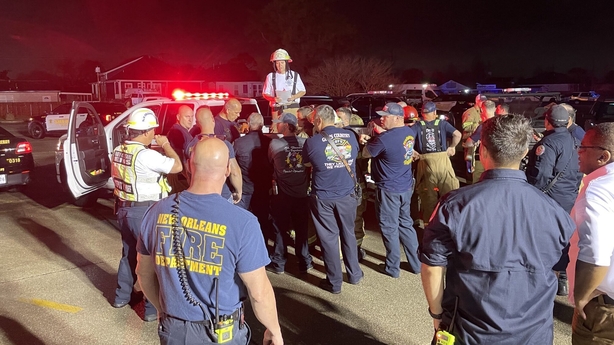At least one person was killed and homes destroyed as a tornado ripped through New Orleans, in another setback for an area that has yet to fully recover from last year's Hurricane Ida.
A dark funnel cloud touched down in the city yesterday and ploughed through neighbourhoods, pictures on social media showed, with damage reported in the communities of Arabi, Gretna and St Bernard Parish.
St Bernard Parish President Guy McInnis said at least one person was killed.
The Washington Post, citing a spokesman for Mr McInnis, said the person killed was a 26-year-old man who emergency services found outside his home in the Arabi area.
Some other residents had been hospitalised with non-life-threatening injuries, the spokesman said, but there was no official tally of the number of casualties.
"We had five or six houses totally demolished. There were people in the homes, so far everyone is accounted for," Mr McInnis said on WDSU television.
03/22/2022. NOFD assisting St Bernard FD, Search & Rescue, Tornado. Photos by Chief C Mickal, NOFD Photo Unit. pic.twitter.com/ozouN70rEB
— NOFD (@NOLAFireDept) March 23, 2022
St Bernard Parish Sheriff Jimmy Pohlmann told news site NOLA.com he had reports of some people trapped.
In Arabi, the tornado blew off roofs and knocked over trees and utility poles, NOLA.com reported.
A video posted on Twitter by Fox8 television showed firefighters near a house in Arabi with no roof and its walls toppled over.
Much of southern Louisiana is still recovering from Hurricane Ida, a fierce Category 4 storm that came ashore last August, devastating rural communities to the south of New Orleans and killing more than 100 people in the South and Caribbean.
Hurricane Katrina, one of the largest and most powerful storms in US history, devastated New Orleans, killing at least 1,800 people in 2005.
Yesterday's tornado struck a day after twisters destroyed homes and injured people elsewhere in the region.

The storm front brought heavy rain and powerful winds to Louisiana, Mississippi and Alabama.
National Weather Service forecasters had earlier warned that some 5 million people in the region could see dangerous weather.
"This is the typical time of the year for these events to unfold. Spring-time is prime for severe weather," said Roger Erickson, a National Weather Service meteorologist in Lake Charles, Louisiana.
School districts across the region cancelled classes and Louisiana State University in Baton Rouge closed its campus for the day.

